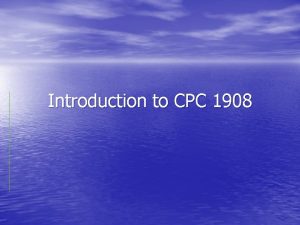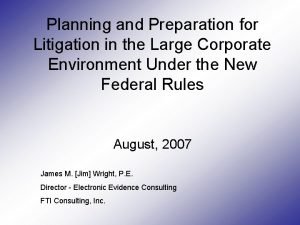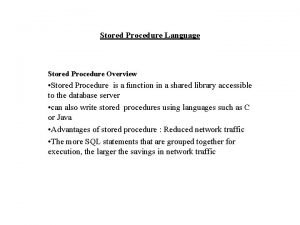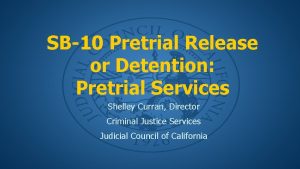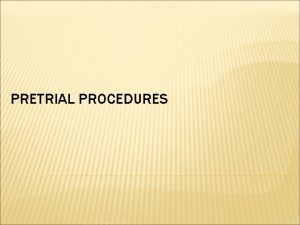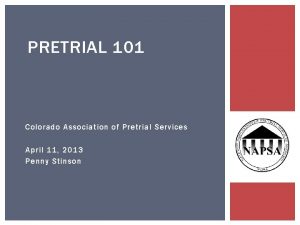Civil Pretrial Practice Overview of Civil Pretrial Procedure











- Slides: 11

Civil Pretrial Practice Overview of Civil Pretrial Procedure

Required Text & Course Materials ▪ O’Connor’s California Practice – Civil Pretrial 2017 (“O’Connor”) ▪ California Code of Civil Procedure (“CCP”) ▪ California Rules of Court (“CRC”) ▪ Local Rules for the Superior Court of California, County of Los Angeles (“LASCR”) ▪ Judicial Council of California Civil Jury Instructions (“CACI”)

Grading Criteria & Evaluation Plaintiff Attorneys Assignment Defense Attorneys Due Date Points Assignment Due Date Points Memorandum to Supervisor re Case Evaluation August 30, 2018 5 Complaint September 6, 2018 5 Demurrer to Complaint September 13, 2018 15 Opposition to Demurrer September 20, 2018 15 Answer to Complaint September 20, 2018 5 Motion to Compel October 4, 2018 15 In-class Motion Writing Assignment October 11, 2018 10 Mediation Brief October 25, 2018 15 Trial Binder November 15, 2018 10 Classroom Preparation and Participation (including depositions and oral arguments) 25 Total 100

The California Court System In California, there are two kinds of court cases: civil and criminal. Civil Cases Criminal Cases ▪ "Civil" cases are the cases in court that aren’t about breaking a criminal law (called a violation of criminal law). There are many different kinds of cases in Civil Court. You file a civil case, or "action" in Civil Court if you think you’ve been hurt, financially or physically. When you are hurt, it’s usually called a "tort". The Civil Court deals with things like car accidents, and contract disputes. ▪ If the State thinks you have committed a crime, the District Attorney’s Office, representing the State, may bring criminal charges against you. Only the State – not another person or agency – can charge you with a criminal violation. There are 3 different kinds of criminal cases: infraction, misdemeanors and felonies. – An infraction is a minor violation. Some traffic violations are infractions. A misdemeanor is a more serious crime that can be punished by up to 1 year in jail. – A felony is the most serious kind of crime. If you are found guilty, you can be sent to state prison or receive the death penalty.

The California Civil Court System In California, the civil courts are divided into two systems: federal and state. California has two types of state courts: Trial Courts Appellate Courts ▪ Trial Courts are also called "Superior Courts. ” In the Trial Courts, a judge, and sometimes a jury, hears testimony and evidence and decides a case by applying the law to the facts of the case. Superior Courts handle: ▪ The Courts of Appeal are California's intermediate courts of review. People who are not satisfied with a Trial Court decision can appeal their case in an Appellate Court. When they "appeal", they ask a higher-level court to change what the Trial Court decided. The role of the Courts of Appeal is not to give new trials, but to review the Superior Court record (court files and transcripts) to decide if legal errors were made. – All civil cases (family law, probate, juvenile, and other civil cases) – Appeals of small claims cases and other civil cases worth $25, 000 or less ▪ The Supreme Court is the state's highest court. It can review cases decided by the Courts of Appeal.

Stages of a Civil Lawsuit 1. Client Retention 2. Pre-Litigation or Prefiling 3. Litigation 4. Trial 5. Post-Trial

Stage 1 – Client Retention • Client Retention begins when you first consider representing a potential client. • You must determine whether or not you would like to retain the client and represent them in their case. • It is important to thoroughly investigate the law and facts regarding the potential client’s case before retaining them. • If you determine that you would like to represent a potential client, you must take steps to formally retain them.

Stage 2 – Pre-Litigation or Prefiling • Pre-Litigation takes place from the moment a client is retained until a formal lawsuit is filed. • Prior to filing a lawsuit, you should investigate as much factual evidence about the case in order to determine: • Who has standing to file the lawsuit. • Who the lawsuit can be against. • When to file the case. • Where to file the case. • Whether to file the case. • Cases often settle during prelitigation, which may save everyone involved significant time and expense of going through the litigation process.

Stage 3 – Litigation begins when a plaintiff initiates a lawsuit by filing a Complaint. To the left is a flow chart showing how a civil case moves through the court system.

Stage 4 – Trial • Trial is the process in which each side presents evidence backing its version of the facts and provides legal arguments about which laws apply to the case. The jury (or the judge if there is no jury) decides the facts, and the judge decides which laws apply to these facts • Trials may be required if the parties are unable to settle the case through the pre-trial litigation process. • Statistically, anywhere from 80% to 95% of civil cases settle before trial.

Stage 5 – Post-Trial • Post-Trial is the period after the trial ends and includes procedures and methods for enforcing or challenging trial decisions. • Parties who are displeased with the trial result may challenge the verdict through a variety of posttrial motions. • Trial decisions can also be appealed by the losing party or the winning side can begin the process of collecting the judgment.


